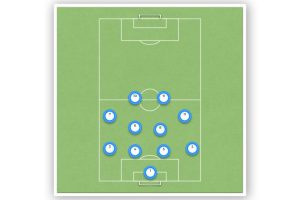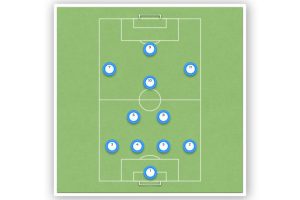Soccer Formations for 11 v 11: A Comprehensive Guide
As a soccer player and coach, I understand the importance of choosing the right formation for an 11 v 11 game. The formation can make or break a game, as it determines the positions and roles of each player on the field. With so many different formations to choose from, it can be overwhelming to decide which one to use. However, by understanding the strengths and weaknesses of each formation, you can make an informed decision and give your team the best chance of success.
One of the most popular formations in soccer is the 4-4-2, which consists of four defenders, four midfielders, and two forwards. This formation provides a balance between defense and offense, as the midfielders can support both the defense and the forwards. Another popular formation is the 4-3-3, which has four defenders, three midfielders, and three forwards. This formation is more attacking than the 4-4-2, as it allows for more players to push forward and create scoring opportunities.
It’s important to note that there is no one-size-fits-all formation for soccer. The right formation for your team will depend on various factors, such as the strengths and weaknesses of your players, the style of play you want to implement, and the opponent you’re facing. By experimenting with different formations and analyzing their effectiveness, you can find the perfect formation for your team and lead them to victory.
Basic Principles of Soccer Formations
As a soccer player, I know how important it is to have a solid formation that fits the team’s style of play. A formation is a basic framework that outlines the positions and responsibilities of each player on the field. In this section, I will discuss the basic principles of soccer formations, including defensive and offensive strategies, the importance of positioning, and player roles and responsibilities.
Defensive and Offensive Strategies
Defensive and offensive strategies are crucial components of any soccer formation. A good defensive strategy is designed to prevent the opposing team from scoring by limiting their opportunities to advance the ball towards the goal. This can be achieved by positioning defenders in key areas of the field, such as the center-backs in front of the goal or the full-backs on the flanks.
An effective offensive strategy, on the other hand, is designed to create scoring opportunities by moving the ball into the attacking third of the field. This can be achieved by positioning forwards and midfielders in advanced positions and using quick passes and dribbling to break down the opposing team’s defense.
Importance of Positioning
Positioning is another important aspect of soccer formations. Each player has a specific role and responsibility based on their position on the field. For example, defenders are responsible for stopping the opposing team’s forwards from scoring, while midfielders are responsible for controlling the flow of the game and creating scoring opportunities for the forwards.
It is important for players to maintain their positions and not stray too far from their designated areas, as this can create gaps in the defense or limit the team’s attacking options.
Player Roles and Responsibilities
Understanding player roles and responsibilities is crucial for the success of any soccer team. Each player has a specific role to play based on their position, and it is important for them to understand their responsibilities and execute them effectively.
For example, a striker‘s main responsibility is to score goals, while a goalkeeper’s main responsibility is to prevent the opposing team from scoring. Midfielders, meanwhile, are responsible for controlling the flow of the game and creating scoring opportunities for the forwards. It is important for players to communicate with each other and work together to achieve the team’s goals.
Popular Soccer Formations for 11 v 11
4-4-2 Formation

The 4-4-2 formation is one of the most popular soccer formations for 11 v 11 games. It is a balanced formation that provides both defensive and offensive capabilities. The formation consists of four defenders, four midfielders, and two forwards. The four defenders usually play in a flat back line, with two central defenders and two full-backs. The four midfielders are typically arranged in a similar way unless you’re playing a 4-4-2 diamond shape, with a defensive midfielder, two central midfielders, and an attacking midfielder. The two forwards play up front and are responsible for scoring goals.
4-3-3 Formation

The 4-3-3 formation is another popular formation for 11 v 11 soccer games. It is an attacking formation that is designed to score goals. The formation consists of four defenders, three midfielders, and three forwards. The four defenders play in the same way as in the 4-4-2 formation. The three midfielders are arranged in a triangle shape, with a defensive midfielder, a central midfielder, and an attacking midfielder. The three forwards are arranged in a line, with a central forward and two wingers.
3-5-2 Formation

The 3-5-2 formation is a more modern formation that has become popular in recent years. It is an attacking formation that is designed to control the midfield. The formation consists of three defenders, five midfielders, and two forwards. The three defenders play in a central position, with two central defenders and a sweeper. The five midfielders are arranged in a diamond shape, with a defensive midfielder, two central midfielders, and two attacking midfielders. The two forwards are arranged in a line, with a central forward and a second forward who can play as a striker or a midfielder.
4-2-3-1 Formation

The 4-2-3-1 formation is a variation of the 4-4-2 formation that is designed to provide more attacking options. It consists of four defenders, two defensive midfielders, three attacking midfielders, and one forward. The four defenders play in the same way as in the 4-4-2 formation. The two defensive midfielders are responsible for protecting the defense and providing a link between defense and attack. The three attacking midfielders are arranged in a line, with a central attacking midfielder and two wingers. The forward plays up front and is responsible for scoring goals.
5-3-2 Formation
The 5-3-2 formation is a defensive formation that is designed to prevent the opposition from scoring. It consists of five defenders, three midfielders, and two forwards. The five defenders play in a central position, with three central defenders and two wing-backs. The three midfielders are arranged in a line, with a central midfielder and two attacking midfielders. The two forwards play up front and are responsible for scoring goals.
Want to know more? 6 v 6 Soccer Formations
How to Choose the Right Formation
Choosing the right formation for your team can make a big difference in the outcome of a game. As the coach, it’s your responsibility to assess your team’s strengths and weaknesses, analyze your opponent’s formation, and adapt to game situations. Here are some important factors to consider when choosing the right formation:
Assessing Team Strengths and Weaknesses
Before choosing a formation, it’s important to assess your team’s strengths and weaknesses. Take a look at each player’s individual skills and abilities and determine how they can best contribute to the team. For example, if you have a strong midfield, you may want to consider a formation that emphasizes possession and control of the ball.
It’s also important to consider your team’s overall style of play. If you have a fast, aggressive team, you may want to choose a formation that allows for quick counterattacks and aggressive play. On the other hand, if your team is more methodical and patient, you may want to choose a formation that emphasizes possession and building up play slowly.
Analyzing Opponent’s Formation
Another important factor to consider when choosing a formation is your opponent’s formation. Analyze their strengths and weaknesses and determine how your formation can exploit their weaknesses and neutralize their strengths. For example, if your opponent has a weak defense, you may want to choose a formation that emphasizes attacking down the wings and creating crosses into the box.
It’s also important to consider your opponent’s style of play. If they like to play a possession-based game, you may want to choose a formation that emphasizes pressing and counterattacks. On the other hand, if they like to play a more direct style, you may want to choose a formation that emphasizes defense and counterattacks.
Adapting to Game Situations
Finally, it’s important to be able to adapt your formation to game situations. If you’re winning and your opponent is pressing hard, you may want to switch to a more defensive formation to protect your lead. On the other hand, if you’re losing and need to score quickly, you may want to switch to a more attacking formation and take more risks.
It’s also important to be able to make substitutions and adjust your formation on the fly. If a key player gets injured or isn’t performing well, you may need to make a substitution and adjust your formation accordingly.
Conclusion
After researching and analyzing various soccer formations for 11 v 11, I have come to the conclusion that there is no one-size-fits-all approach. Each team and player has their strengths and weaknesses, and the right formation will depend on the type of players you have in your team and the style of play you want to implement.
That being said, some formations have proven to be more effective than others. The 4-3-3 formation, for example, provides excellent options in the attack and good support on the defensive side of the ball with four defenders and midfielders providing support just in front of the backline. The 3-5-2 formation, on the other hand, provides a solid defensive structure with three center backs and two wingbacks providing width in attack.
It’s also important to note that formations are not set in stone and can be adjusted throughout the game based on the flow of play and the opposition’s tactics. Coaches and players should be flexible and adaptable, willing to make changes when necessary to gain an advantage.
Ultimately, the key to success in soccer is not just the formation, but the teamwork, communication, and individual skills of the players. By working together and utilizing their strengths, any team can achieve success on the field.




